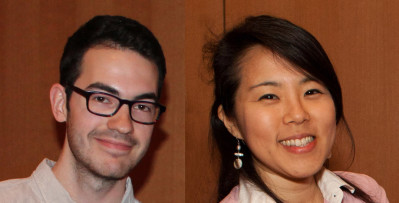
A key goal of the Y-Prize Competition is to foster collaboration between various schools at Penn. Isabelle Park, an MBA candidate at the Wharton School, and Gavin Kenneally, a Ph.D. Candidate in Mechanical Engineering, describe the joys and challenges of working on a cross-disciplinary team.
What role did you play in shaping the final idea for TRHex?
Gavin: As the Tech Consultant, I worked with Emily and Izzy to develop the preliminary TRHex prototypes with emphasis on designing the way kids would be able to interact with the robot. We thought a lot about getting kids to program gaits physically and intuitively by simply moving the robot’s legs to different poses.
Izzy: As the Business Consultant, I worked on how to take TRHex to the market. The team had already gathered considerable feedback from national museums, Philadelphia schools, and private institutions. It was now time to synthesize all of that together to craft a successful business plan and compelling pitch.
I helped them communicate the story of TRHex, along with how to address operational risks and focus on their competitive advantages. We went through multiple iterations of the presentation and rehearsed intensely. I knew the competition was going to be stiff so we had to bring our best to the table. All in all, it was a great joy to work with TRHex – the team got along extremely well and it was truly a multidisciplinary effort.
How did your background make you a good fit for the team?
Gavin: Formally, my background is in Mechanical Engineering with an emphasis on Robotics. My approach is very hands on and I’ve been designing, building, and sharing physical machines for many years. I first started to think carefully about getting kids interested in Robotics during an after school program I organized and ran at the Kateri Tekakwitha school in Kahnawake, Quebec. At the time I had to modify various hobby parts for the kids to work with, an experience that would now be greatly facilitated by TRHex!
Izzy: I don’t think the team realized this, but I’m very passionate about promoting STEM education. I started as a finance major in undergrad. A friend recommended in passing that I take an introductory computer science course, so I did. The next day, I walked into the Engineering academic advising office and convinced them to let me take higher level courses and any class I could get into. That one class for me was the same “spark” that changed Emily’s career trajectory forever when she joined a high school robotics team. I instantly recognized the vision for TRHex and knew exactly what we needed to do.
What challenges did you have to overcome as a team?
Gavin: I think the greatest challenge on the hardware side is the compromise between performance, capability, and price. The robot experience needs to be rich enough to engage and challenge kids of varying ages through many different interactions, all while making concrete links to what they’re learning in class.
Izzy: I think many of us get bogged down into the nitty gritty details without understanding the big picture. There were a number of different ways the team could have taken TRHex to market and we spent a lot of time discussing those strategies. We each brought very different approaches, so aligning on the big vision for TRHex was critical to a successful collaborative effort between business and engineering.
Great businesses are built on solid principles and a strong core mission. Our job as a team was to take the audience on a great journey, one that was worthy of inspiring the future leaders of science and technology.
Previously: Head judge Tom Fitzsimons on what made TRHex stand out. Up next: Grand Prize winner Emily Plumb describes the inspiration that sparked the idea.



